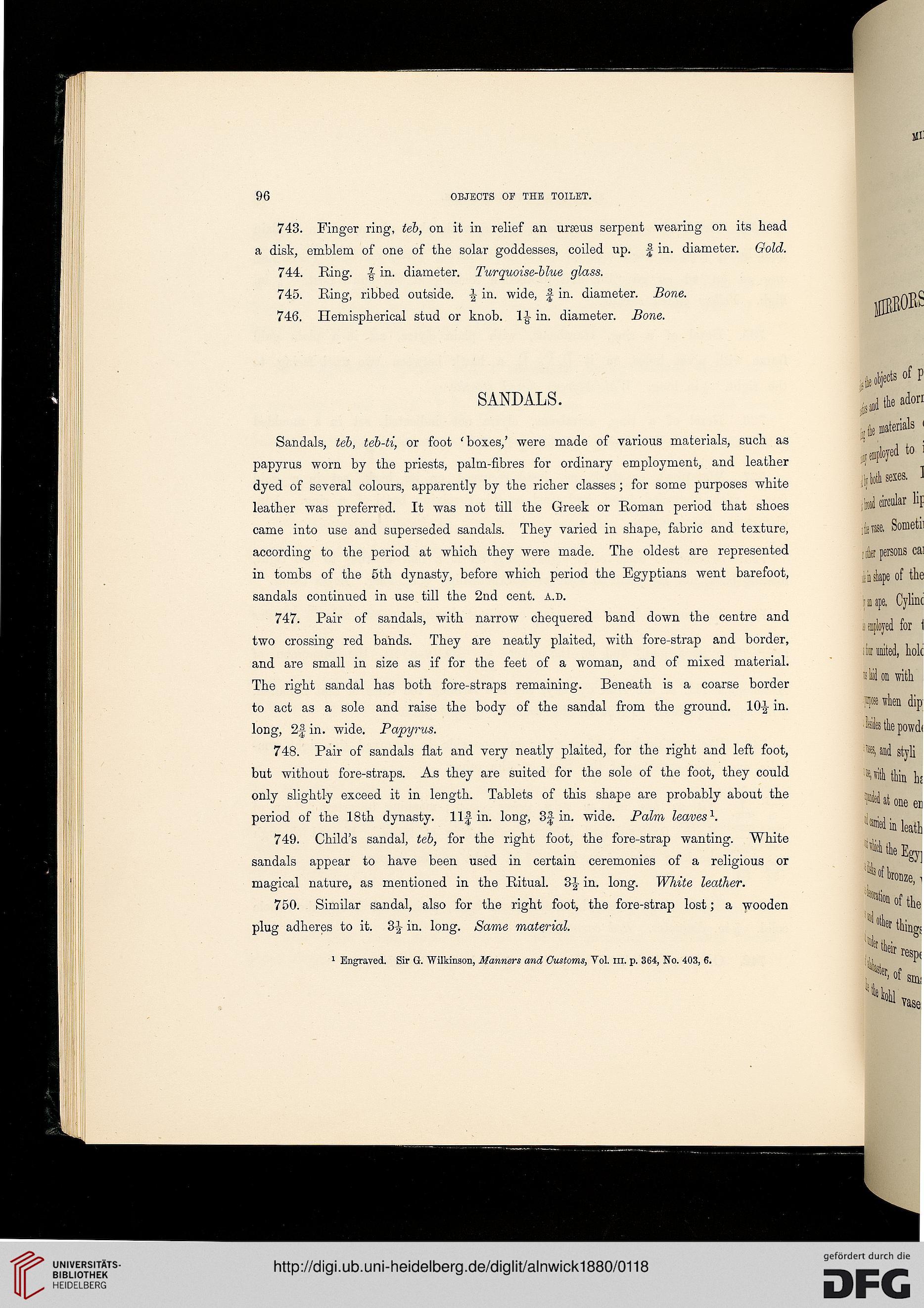ill
96 OBJECTS OF THE TOILET.
743. Finger ring, teb, on it in relief an urseus serpent wearing on its head
a disk, emblem of one of the solar goddesses, coiled up. f in. diameter. Gold.
744. King. -| in. diameter. Turquoise-blue glass.
745. Ring, ribbed outside. in. wide, f in. diameter. Bone.
746. Hemispherical stud or knob. 1^- in. diameter. Bone.
Engraved. Sir G. Wilkinson, Manners and Customs, Vol. nr. p. 364, No. 403, 6.
JIBBOBS
, the objects ofp
SANDALS. iMori
terials
id to
loth sexes. 1
i circular lif
-an ape. Cylinc
• tmployed for \
united, hole
M on with
Sandals, teb, teb-ti, or foot 'boxes/ were made of various materials, such as
papyrus worn by the priests, palm-fibres for ordinary employment, and leather
dyed of several colours, apparently by the richer classes ; for some purposes white
leather was preferred. It was not till the Greek or Roman period that shoes
came into use and superseded sandals. They varied in shape, fabric and texture, ;.;Tise. Sometli
according to the period at which they were made. The oldest are represented 'ir persons cai
in tombs of the 5th dynasty, before which period the Egyptians went barefoot, - in shape of the
sandals continued in use till the 2nd cent. a.d.
747. Pair of sandals, with narrow chequered band down the centre and
two crossing red bands. They are neatly plaited, with fore-strap and border,
and are small in size as if for the feet of a woman, and of mixed material.
The right sandal has both fore-straps remaining. Beneath is a coarse border
to act as a sole and raise the body of the sandal from the ground. 10-| in. 3® <%
long, 2|in. wide. Papyrus. Wes the powd<
748. Pair of sandals flat and very neatly plaited, for the right and left foot, and styli
but without fore-straps. As they are suited for the sole of the foot, they could R^ft ^ ^r
only slightly exceed it in length. Tablets of this shape are probably about the
period of the 18th dynasty. 11J in. long, 3^ in. wide. Balm leaves1.
749. Child's sandal, teb, for the right foot, the fore-strap wanting. White
sandals appear to have been used in certain ceremonies of a religious or
magical nature, as mentioned in the Pitual. 3£ in. long. White leather. , Ze> 1
750. Similar sandal, also for the right foot, the fore-strap lost; a wooden 1011 °f the
plug adheres to it. 3^ in. long. Same material ^ things
■Ned at one er
^inleath
^htheEgy]
tttebesp(
<>f SDH
^ vase
96 OBJECTS OF THE TOILET.
743. Finger ring, teb, on it in relief an urseus serpent wearing on its head
a disk, emblem of one of the solar goddesses, coiled up. f in. diameter. Gold.
744. King. -| in. diameter. Turquoise-blue glass.
745. Ring, ribbed outside. in. wide, f in. diameter. Bone.
746. Hemispherical stud or knob. 1^- in. diameter. Bone.
Engraved. Sir G. Wilkinson, Manners and Customs, Vol. nr. p. 364, No. 403, 6.
JIBBOBS
, the objects ofp
SANDALS. iMori
terials
id to
loth sexes. 1
i circular lif
-an ape. Cylinc
• tmployed for \
united, hole
M on with
Sandals, teb, teb-ti, or foot 'boxes/ were made of various materials, such as
papyrus worn by the priests, palm-fibres for ordinary employment, and leather
dyed of several colours, apparently by the richer classes ; for some purposes white
leather was preferred. It was not till the Greek or Roman period that shoes
came into use and superseded sandals. They varied in shape, fabric and texture, ;.;Tise. Sometli
according to the period at which they were made. The oldest are represented 'ir persons cai
in tombs of the 5th dynasty, before which period the Egyptians went barefoot, - in shape of the
sandals continued in use till the 2nd cent. a.d.
747. Pair of sandals, with narrow chequered band down the centre and
two crossing red bands. They are neatly plaited, with fore-strap and border,
and are small in size as if for the feet of a woman, and of mixed material.
The right sandal has both fore-straps remaining. Beneath is a coarse border
to act as a sole and raise the body of the sandal from the ground. 10-| in. 3® <%
long, 2|in. wide. Papyrus. Wes the powd<
748. Pair of sandals flat and very neatly plaited, for the right and left foot, and styli
but without fore-straps. As they are suited for the sole of the foot, they could R^ft ^ ^r
only slightly exceed it in length. Tablets of this shape are probably about the
period of the 18th dynasty. 11J in. long, 3^ in. wide. Balm leaves1.
749. Child's sandal, teb, for the right foot, the fore-strap wanting. White
sandals appear to have been used in certain ceremonies of a religious or
magical nature, as mentioned in the Pitual. 3£ in. long. White leather. , Ze> 1
750. Similar sandal, also for the right foot, the fore-strap lost; a wooden 1011 °f the
plug adheres to it. 3^ in. long. Same material ^ things
■Ned at one er
^inleath
^htheEgy]
tttebesp(
<>f SDH
^ vase




